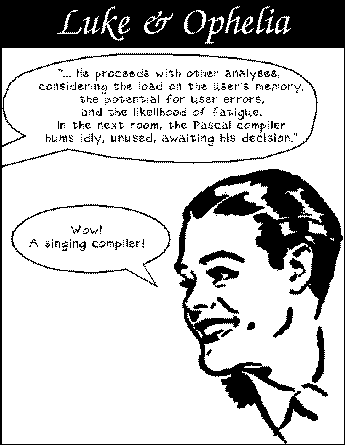Issue
Article
Vol.28 No.3, July 1996
Article
Issue
Issue |
Article |
Vol.28 No.3, July 1996 |
Article |
Issue |
When I was a teenager, I had a lucky experience. I was cycling quite fast on my bicycle along a quiet back street, when a young child ran out in the road ahead of me, at a great enough distance for me to think "Silly Child", but not to have to slow down, since the child was already out of my way.
At that point the child stopped in the middle of the road, and realising that running out into the middle of the road was something that wasn't allowed, promptly turned round and ran back, straight into the path of my bike.
I call this a lucky experience because 1) I was only riding a bicycle at the time, 2) the child only ended up with a fright and maybe a bruise (and hopefully had properly learned the lesson), and 3) I too had learned an important lesson: people don't do what you expect them to do. This is of course also the reason user-testing is necessary when you design a new system.
Now I have observed that amongst car drivers there are two types: those who seem to have learned the same lesson, and slow down when it looks like there may be a dangerous situation ahead (such as someone stepping out into the road in front of them), and those who use their horn instead of their brakes (just on the off-chance that you hadn't heard the noise of their car already) to warn you that they have no intention of going to the inconvenience of actually slowing down or anything.
Now I suspect that some of those drivers are also user-interface designers and implementors.
Take for instance portable computers.
The machine I use has a so-called instant-start option. I'm sitting in the middle of a meeting, and I switch my machine on. What does it do? It beeps. Does it beep once? No, it beeps five times. Does it beep with short little blips. No it beeps with long full beeps. Does it beep softly then? No, it beeps just about as loud as it can without actually destroying the loudspeaker in the process.
Now what is the machine trying to tell me? That I've switched it on? That I haven't got the external floppy drive plugged in (it only beeps four times if I have)? Or is just an unbridled expression of joy at being awake again? In any case for a few brief seconds I'm at the centre of all attention in that meeting before the work can continue.
Why did the designer of that machine (or maybe the author of one or more of the device drivers -- I wouldn't know how to find out what is making the beeps) think it would in any way improve the usability of the machine by beeping madly when it gets switched on? I had even gone to the trouble of selecting the option "Turn beeps off" in the Configuration program, but apparently that program has a different notion to me of what it means to turn something off.
Unfortunately computer manufacturers seldom provide volume controls to turn down or turn off the loudspeaker for when you're using the machine in quiet surroundings. I know people who have cut through the wires leading to their loudspeaker, or taped pads of cotton wool over it.
I have another example. Same portable machine. When I boot it up, lots of drivers and goodness knows what get loaded before the machine is usable. They load so fast that the messages they produce scroll off the top of the screen before you get a chance to actually read them. Several of those programs producing those messages beep at the same time in order to draw your attention to some situation that they have detected. Unfortunately by the time the beep is finished their messages are already scrolled off the screen, so I have still not been able to discover the cause of those beeps and whether I need to take any action. I think one is telling me that there is no CD drive attached to the machine, which I actually knew already, since I've got eyes.
One last example. My workstation at work. I use a virtual window manager and consequently have several dozen windows open or iconified. My machine beeps. Which window has beeped? Mail? Was it a terminal? What should I do? I usually just ignore it.
The question is this: what are beeps good for? The answer is: for drawing the attention of the user who isn't looking at the screen to some situation which needs to be dealt with. All the rest is just noise.
Steven Pemberton
Contributions to Views and Feelings are welcomed. They should be around 800 words long.

Issue |
Article |
Vol.28 No.3, July 1996 |
Article |
Issue |